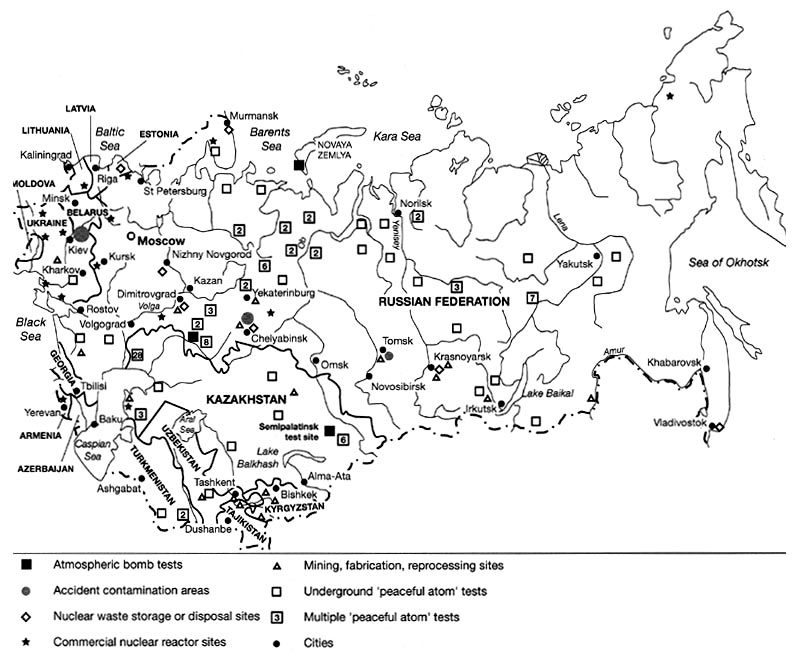Please put an active hyperlink to our site (www.rusnature.info) when you copy the materials from this page
Environmental problems of Northern Eurasia
Radioactive Contamination
<<< The Semipalatinsk Test Site
| Environmental Problems Index | 'Peaceful
Atom' Explosions >>>
Contamination Concerns in the Arctic Region
Existing and potential sources of nuclear contamination in the Russian Arctic region,
especially on the Kola peninsula and on Novaya Zemlya, are of international concern. There
are numerous locations on the Kola peninsula where nuclear fuels and reactor components
are stored. They include Murmansk and Severomorsk, home ports for nuclear submarines and
ice-breakers of the Russian Northern Fleet, at Litsa, a submarine base about 45 km from
the Norwegian border, and at Kildin, an island in the Barents Sea. The Bellona Foundation
in Norway has published extensively on radioactive waste problems in this region (e.g.,
Nilsen and Bohmer, 1994).
The extent and location of radioactive waste sites on and around Novaya Zemlya became
public knowledge in 1992, and was widely reported (e.g., Bradley, 1992b; New York Times,
24 November 1992). There are about eleven offshore waste repository sites, some near the
coast but one around 100 km out into the Kara Sea. These sites contain various types of
spent reactors, at least four scuttled ships with nuclear reactors, and thousands of
individual waste containers.

Fig. 19.1 Radioactive waste and contamination in the former Soviet
republics. After Pryde and Bradley (1994)
Two sites on Novaya Zemlya have been used for nuclear weapons tests. In all, 132 tests
were conducted between 1955 and 1990: 86 in the atmosphere, 43 underground, and 3 under
water. Twenty-eight of the underground blasts vented radiation to the atmosphere (Matzko,
1994). The first nuclear detonation on Novaya Zemlya in 1955 was set off beneath Chernaya
Bay, and very high levels of caesium and plutonium are still present in the bottom
sediments. These are confined in the sediments for the time being, but are of long-term
concern in the context of the Arctic Ocean food chain. The largest nuclear device ever
exploded (58 megatonnes) was detonated over Novaya Zemlya in 1961 and produced fallout
recorded all around the Northern Hemisphere. Ninety-four per cent of the combined
explosive force of all the USSR's nuclear tests were detonated at Novaya Zemlya (Nilsen
and Behmer, 1994). Other than at three specific test locations, radiation levels on the
surface of Novaya Zemlya are today described as 'only marginally above background level'
(Bradley, 1997).
Russian Federation officials have acknowledged that the USSR deposited highly
radioactive wastes into many locations in the Barents and Kara Seas from 1964 to 1986
(Yablokov, 1993). Various sources have suggested that at least 10 000 or 11 000 containers
of radioactive wastes have been dumped in violation of the London Convention, which
prohibits ocean dumping of nuclear wastes (Izvestia, 29 October 1991; Nuclear Waste News,
28 November 1991). These wastes include the damaged core from the nuclear ice-breaker
Lenin, sunk off Novaya Zemlya in the 1960s.
This has led to concern for the overall condition of the Kara Sea. Including the
dumping mentioned in the preceding paragraph, radioactivity has reached (and in some cases
is still reaching) the Kara Sea from five different sources or avenues: (1) direct dumping
of wastes or waste containers; (2) fallout from atmospheric testing (at Novaya Zemlya or
elsewhere); (3) releases from West European fuel reprocessing plants; (4) fallout from
Chernobyl; (5) radioactive material carried by the Ob and Yenisey river systems.
Estimates of the total amounts of strontium-90 carried to the Kara and Barents Seas
range from 64 000 to 180 000 Ci; a somewhat greater amount of caesium-137 has been
estimated. The largest single source of caesium-137 to the Barents Sea is reprocessing
wastes dumped by Great Britain at Sellafleld and by France at La Hague (Bradley, 1997).
The great majority of the wastes in the Kara Sea is either in containers or in bottom
sediments, and hence poses no immediate danger to humans. The concern is over possible
future disturbances to these repositories, and to unknown ecological effects to the
oceanic food chains.
Within the same watershed, wastes from the Beloyarsk nuclear power plants have been
discharged into the nearby Olkhovka marshes, giving concern that they may eventually
pollute the Tobol river system (Nuclear Waste News, 10 October 1991 and Atomnaya Energiya,
September 1991, as reported in Bradley, 1992a).
There are several nuclear facilities situated along the shores of the Russian Far East.
As on the Kola peninsula, submarine and other nuclear wastes are stored here, often
improperly, and at least one serious accident has taken place. An explosion in a
submarine's nuclear reactor occurred on 10 August 1985, at the Chazhma Ship Repair
Facility in southern Maritime Province. Radioactivity was spread over a distance of
several kilometres. There have also been reports of a leak in 1990 at a nuclear waste
storage site on the Kamchatka peninsula, when a crack was discovered in the frame of a
storage container for untreated high level wastes (Bradley, 1997).
<<< The Semipalatinsk Test Site
| Environmental Problems Index | 'Peaceful
Atom' Explosions >>>
Contents of the Radioactive Contamination
section:
Other sections of Environmental Problems of Nortern Eurasia:
|
|